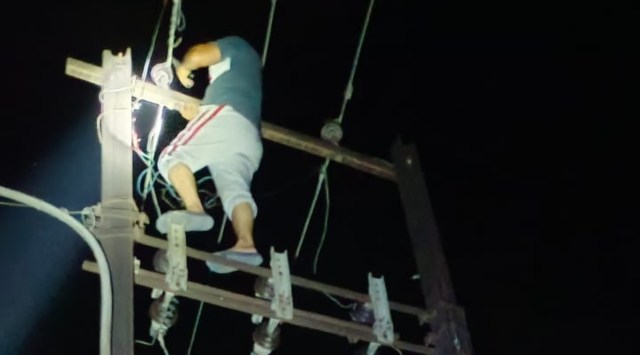Stay updated with the latest - Click here to follow us on Instagram
Unscheduled power cuts add to summer woes; PSPCL says no shortage
Many parts of the state in the last couple of days had been bearing the burnt of unscheduled power cuts especially during night hours, thanks to technical snags and overloading of the transformers.
 PSPCL's hydel generation was around 216 MW in the afternoon hours (Tuesday), while solar generation was around 412 MW on Tuesday afternoon. (Express)
PSPCL's hydel generation was around 216 MW in the afternoon hours (Tuesday), while solar generation was around 412 MW on Tuesday afternoon. (Express) While the Punjab State Power Corporation Limited (PSPCL) authorities claim that there is no gap between demand and supply of power, situation on the ground tells a different story.
Many parts of the state in the last couple of days had been bearing the burnt of unscheduled power cuts especially during night hours, thanks to technical snags and overloading of the transformers.
On the intervening night of May 22-23, many parts of industrial town Ludhiana were powerless due to technical snags and so was the case in Malerkotla where people (electricity consumers) were busy making frantic calls to the complaint centres of PSPCL.
“At nighttime the staff on duty are less in number compared to daytime and so they are not able to attend all the complaints well in time. Moreover employees refrain from going on night duty on the outskirts of the city where crime rate is high,” said a field staff member of PSPCL who was on night shift on Monday on the outskirts of Ludhiana.
In Pakhowal road and adjoining areas in Ludhiana, households remained powerless throughout the night.
S R Vashishat, PSPCL chief engineer of Central Zone, Ludhiana, while talking to The Indian Express said, “We did a meeting on Tuesday in which we increased the night staff. Heatwave has resulted in an increase in the demand for power due to which at times faults do develop. Otherwise there’s no gap between demand and supply of electricity.”
On Tuesday afternoon the peak demand in the state reached 11800 MW which had dipped to around 9000 MW by late evening due to rain in some parts of Punjab. However, out of this, nearly 5300 MW is in-house generation, while the rest is purchased by PSPCL as the in-house generation didn’t increase even by 1 MW in the past many years.
“More than 800 MW generation has been reduced by shutting down Guru Nanak Dev Thermal Plant (GNDTP) in Bathinda and two units of Guru Gobind Singh Super Thermal Power Plant (GGSSTP) in Ropar in January 2018,” said Gursewak Singh, a retired GNDTP employee, while talking to The Indian Express.
At present, Punjab has a total thermal power generation capacity of 5680 MW out of which 1760 MW is from government-owned thermal plants and the rest 3920 MW by independent power plants (IPPs). As three thermal units are out of order, PSPCL has to buy more power from outside sources. These include 210 MW units each of government-owned Guru Hargobind Thermal Plant (GHTP), Lehra Mohabbat in Bathinda district, and GGSSTP, Ropar. In addition to this, 660 MW unit of Talwandi Sabo Thermal Plant which is an IPP is also out of order.
PSPCL authorities said that units at GGSSTP (Ropar) and Talwandi Sabo will be operational in a few days. They had been shut down due to boiler tube leakages. However, the 210 MW unit in GHTP (Lehra Mohabbat) had gone down on May 13 last year after its electrostatic precipitator (ESP) got damaged but it hasn’t been repaired till date as it costs over Rs 24 crore and even takes a long time to repair, said PSPCL sources.
“We hope that GHTP’s faulty unit will be back in operation during the paddy season,” said a PSPCL employee while talking to The Indian Express.
PSPCL’s hydel generation was around 216 MW in the afternoon hours (Tuesday), while solar generation was around 412 MW on Tuesday afternoon.
PSPCL authorities said that during day rates in the power exchange are low due to availability of large amount of solar power in the country, so they are purchasing this low-cost power and giving supply to all agriculture power (AP) consumers during day. “Demand during day is high as we are giving supply to all AP feeders during solar hours. Demand during night is around 8000 MW or so on average,” said PSPCL authorities while talking to The Indian Express.
PSPCL authorities maintained that they were not short of power in the state despite high demand and faulty thermal units.
“It seems that work needs to be done more on transmission of power. We are changing cables in many areas these days as they are getting damaged due to overheating and overloading as well,” said a field staff member at Daba road of Ludhiana.







